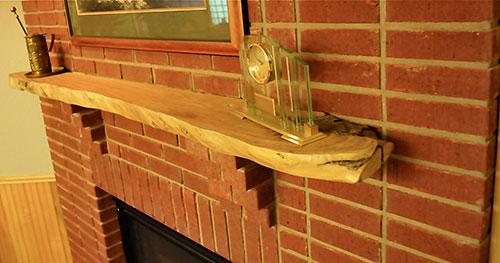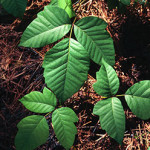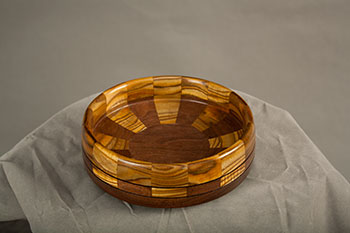How a tree that escaped an early death finally came to rest in the most unexpected of places.
By Dr. Mark Neuzil

In the 1980s, two Midwestern men who were fishing buddies, neighbors and more than moderately skilled in the industrial arts came across a rare old sumac blown down on a fencerow. Unlike most sumac in rural Iowa, this one had escaped a young death, nestled as it was along the barbed wire, out of the way of the mower and the plow. Free from the shade of larger trees, it grew to an unusual height, showing at least 25 growth rings when a strong wind finally ended its life. What the two friends did with the tree was nearly as unusual as its advanced age: Much of it ended up as a mantle in the local funeral chapel, where it sits over the fireplace with a natural olive-green-yellow glow, surprising mourners and giving them something to talk about at a time when conversation can be difficult.

The tree that Jack Neuzil, my father, and his buddy, Don Ochs, made use of was a staghorn sumac, the fruit — called drupes — of which were a source of a lemon-tasting drink for many Native Americans. Staghorn sumac (sometimes called stag’s horn, vinegar, Virginia or velvet sumac) is so named for two reasons, both related to male deer. The branches and pinnate leaves of the staghorn grow in an upright, spreading manner, resembling the antlers of an adult deer; its shoots are covered with a fine, white hair that looks like the velvet skin on a stag’s antlers.
But it was the 35- to 40-foot height of the tree, the relatively straight trunk and the strange, fluorescent quality of its wood that drew my father and Don to it. Along their journey with what became known as the mantle sumac came subtle lessons about the value of a tree often ignored if not downright scorned as a trash species or, worse, a weed.
SUMAC THROUGH THE AGES
Sumac, with about 250 species across the world, has been used throughout history for everything from medicines to a dinner garnish, an ingredient in wax, a tobacco additive and a dye. Various members of the sumac family (Anacardiaceae) can be found in North America, southern Africa, eastern Asia and northeastern Australia in a variety of forms, including deciduous or evergreen, shrubs, trees or woody climbers, in temperate or subtropical climates. In North America, sumacs are common in roadside ditches, known for their brilliant red or orange leaves in the fall.

Sumacs in their ubiquity have been described, catalogued and commented on since olden times. Naturalist Pliny the Elder, writing in the first century, noted the use of the juice of the fruit of the “sumach-tree of Syria” by curriers in the making of leather. Pliny compared the appearance of the seed to that of a lentil and wrote that it “forms a necessary ingredient in various medicaments.” The ancients mistakenly believed it to be a relief for fever, but they were accurate about its ability to help preserve animal skins. The Japanese, in their famous and oft-imitated black lacquers, were said to use its sap. In China, the Chinese characters for sumac literally mean “paint tree.” An 11th-century shipwreck, discovered centuries later off the coast of Rhodes, Greece, was filled with containers of sumac drupes that were being shipped to market.
Native American use varied by tribe. The Abenaki mixed its leaves and berries with tobacco for smoking. The Menominee used its liquid at both ends: as a gargle for coughs and as a relief from hemorrhoids. The milky white juice from a cut twig served them as an astringent. The Cherokee and Delaware applied sumac for any number of problems that required strong medicine, including gonorrhea.
In the 19th-century United States, the tanning industry combined sumac with hemlock to treat leather, while weavers mixed it with gall nuts as a mordant to fix colors in aniline dyes. Writing in The American Botanist in 1909, Frank Dobbin recalled, “Our grand-mothers too had a use for the sumach. They gathered the fruit or ‘bobs’ as they were called, and by boiling them made a dye that would produce a fine shade of silver gray.”

Its value in leather making and dyes led the citizens of rural Appalachia to gather up its leaves in the fall, stuff them into bales and send them to city markets, a venture worth “tens of thousands a year to the income of the State of Virginia,” according to an 1881 estimate in Scribner’s Monthly.
None of these attributes, though, prevents the sumac from sometimes being scorned as a weed with an incorrigible personality. It can grow from seed, of course, but also from its aggressive underground stems, known as rhizomes, which can run far away from the trunk and sprout new shoots. And at least three species are highly toxic — poison oak, poison sumac and poison ivy.
Rhus vernix, poison sumac, is handsome to look at, but hard to handle. “Rhus rash” was an early epithet. A prevailing belief, bought into by no less an authority than Harvard professor Dr. Asa Gray, dean of 19th-century botanists, that smelling a sumac from as far as 20 feet away spreads infection was in error, however. So was the use of horse urine as a cure. Alfred, Lord Tennyson noted that a sumac species provided an ingredient for the “wourali poison made by the natives of Guiana,” a toxin that in modern times we know as curare. And then there is climbing poison ivy, perhaps the most feared and reviled plant in the New World, the creature that the understated Captain John Smith wrote “causeth redness, itchinge, and lastly blysters …”
While these poison sumac varieties are more easily identified by the fruits, which droop from the branch and are white or gray, staghorn sumacs and other non-poisonous varieties can be spotted by the deeply crimson, round and somewhat-hairy drupes they sport on their upright stalks. These stalks are about eight inches high on the female tree and are eaten by dozens of songbirds and game birds, as well as rodents, rabbits and squirrels. Nature writer John Burroughs, in Wake-Robin, described the flavor of the berry appearing in the honey of particular bees in his neighborhood, who mixed sumac nectar with clover, thyme and linden.



TAKING A CHANCE ON SUMAC

In a small Iowa town in 2003, the local funeral home director, Terry Brosch, was building a new chapel a bit farther off the noisy state highway than his old digs. In the large common room, he wanted a red, brick fireplace to stretch along one wall. Terry also wanted a locally sourced mantle over the hearth, so he went to local woodworker Jack Neuzil for ideas. The two spent part of an afternoon digging through foot after foot of board lumber in Jack’s shop before they came to several quartersawn boards, about six feet long and 10 inches wide, of an unusual coloration: an almost glowing yellowgreen, with bold flowing streaks of dark brown. In fact, under a black light, medium to bright streaks of sumac green glow fluorescently. The boards had been leaning in the stacks for perhaps two decades.
“That’s sumac,” Jack said.
“That’s what I want,” Terry replied. “Will it work?”
Jack showed him a child’s stepstool with a dinosaur carved on its step made from the tree.
The sumac, lighter than oak, but heavier than cedar, was sawn, shaped and dropped into place as the mantle for the town’s new funeral chapel. It stretches five or more feet along the top of the fireplace, where mourners can lean on it and stare into the fire or turn away and face their companions. One board from the original staghorn sumac remained.

Seven years passed, until luck visited my house in the person of one of the elite artists and woodworkers in the Midwest, Thomas Schrunk. Among his many accomplishments, Tom provides Steinway with the veneers for its pianos. He has redone a kitchen for the Royal Crescent Hotel (dating from 1767) in Bath, England, and tabletops for the Prince and Princess of Jodhpur. He has counted Ronald Reagan and Sophia Loren as clients.
Each year, Tom holds a fundraising drawing to benefit one of his wife’s projects, with the winner getting a Schrunk veneer table. This time, Tom drew 200 names from a hat, but “just for fun, I decided to award the prize to the last name drawn, rather than the first,” he said. My name was the very final one drawn. By being last, I won.
Rather than select one of his beautiful tables as my prize, I asked Tom if he would be amenable to building a table a bit out of the ordinary, although from a common species. “Sure,” he said. “What kind of wood did you have in mind?”
“Sumac. There is one board left, from a prodigious tree.”
Silence. Then, “Sounds like fun. Let’s have a look at it.”
Tom was not dubious when he saw the sumac, but he was realistic. “There’s a reason that there are only 20 main furniture-grade species in North America,” he said. I was reminded of Thoreau’s tale in Walden of a kitchen table made of “the apple-tree wood.” If apple, why not sumac?
The reasons for “why not” are many. “There are species that grow straight and tall and drop their lower limbs and have very little in terms of knots,” Tom said. Sumac is not one of those species. But we forged ahead.
I found a pattern for a hexagon table from a 1917 Chicago Public Schools industrial arts manual; it looked like it belonged in my early 20th-century bungalow. Twelve small pieces were all we could manage from our remaining board, which had about five inches of usable width. Tom used air-dried black walnut for the table’s pedestal, base and as a frame for the top — we didn’t have enough sumac left for a complete surface. We carefully laid six five-sided pieces of sumac into the outer part of the top; six more two-inch, equilateral-shaped pieces sat inside.
After the table was complete, Tom and I carefully saved the few sumac scraps of various sizes in a paper sack. None of the pieces was more than two or three inches long and an inch wide, but I had an idea. Jim Kuebelbeck, my father-in-law, was fond of turning multi-wood bowls on his old Sears Craftsman lathe. I dropped off the sack, and in a few weeks, he combined them with black walnut to turn a seveninch candy dish. Now, about all that remained of our mantle tree was sawdust and shavings.

At the time, none of us thought of our work as being in sustainable wood, but that’s what happened. Iowa, where our tree was found, is among the farthest western homes for the staghorn sumac in the United States. After our exhaustion of the lumber from the mantle tree, my father and I went on a search for one of similar size in late 2012. Some can grow, as it did, up to 40 feet high and live decades, but we could only find younger trees, nothing more than 12- to 15-feet tall. Spraying, mowing and controlled burns (the thin bark is not fire tolerant) kept any from reaching older age. No longer collected by Virginians for tanning or dye or by Native Americans for a drinkable ade, the staghorn sumac’s only remaining economic importance, according to the U.S. Department of Agriculture, is erosion control.
As our experience showed, this focus on economics overlooks cultural uses. In A Place of My Own, Michael Pollan tells of being “struck by the amount of cultural freight the various wood species had been made to carry, at least the ones we’ve seen fit to bring indoors.” Pollan was thinking of Danish modern furniture usually made of clear maple or arts and crafts rendered in oak. We were at the other end of this idea: a wood that signified nothing indoors to 21st-century westerners because it almost always stayed outside, uncut. The more my father and I looked at the twisted and bent trunks of smaller trees, the more we appreciated the straight, wide section of our mantle sumac, and its use in furniture, a fireplace and a bowl are extraordinary examples of an ordinary tree that lives on.
Dr. Mark Neuzil teaches environmental communication at the University of St. Thomas in St. Paul, Minn.